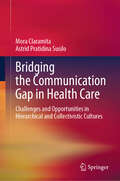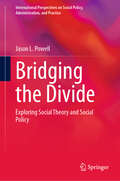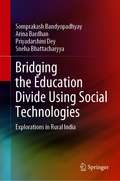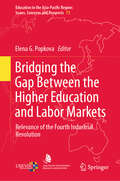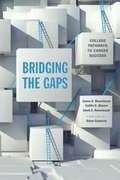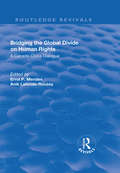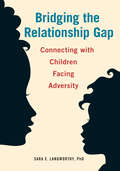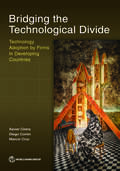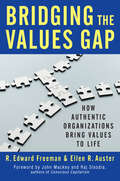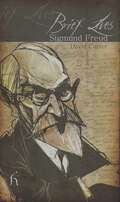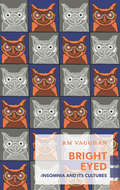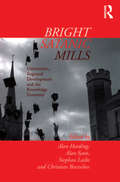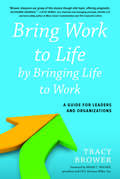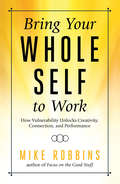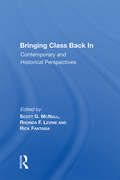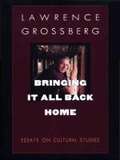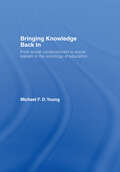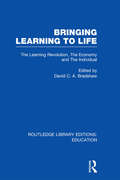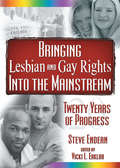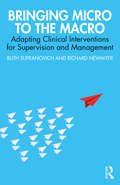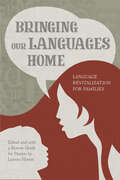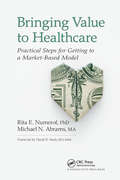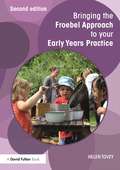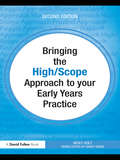- Table View
- List View
Bridging the Communication Gap in Health Care: Challenges and Opportunities in Hierarchical and Collectivistic Cultures
by Mora Claramita Astrid Pratidina SusiloThis book discusses how hierarchical and collectivist cultures contribute to the challenges and opportunities in communication in health care. Failures in communication may result in threats to patient safety. The work is structured around the Hofstede theoretical framework, focusing on two of the six domains of culture, namely hierarchy and collectivism. To date, guidelines on communication practices in health care have been primarily based on Western evidence and thus do not satisfy the needs of other cultural contexts. Existing studies have shown that strong hierarchical and collectivist cultures, transnationally, have different communication practices, with shared characteristics between several countries in Asia, Africa, and South America. Furthermore, when people migrate, they bring their communication styles — which reflect their cultural characteristics — to their new host environment. When not well managed, these differences can yield problematic communication gaps affecting patient care. Building on their extensive work focused on healthcare communication in Southeast Asian cultures, the authors propose remedial approaches and discuss future initiatives for practicing doctors, nurses, pharmacists, and other healthcare practitioners who encounter the daily struggle of cultural miscommunication in their clinical practices. They also address the ways in which patients experience hesitancy when communicating with healthcare providers, owing to cultural barriers. The book proposes how healthcare providers might tackle these communication challenges. It is relevant to educators and researchers in medical and health professions education and public health, and for all patients' advocates, who are looking to enhance their communication skills to improve patient care and safety.
Bridging the Divide: Exploring Social Theory and Social Policy (International Perspectives on Social Policy, Administration, and Practice)
by Jason L. PowellIn today's complex and rapidly changing globe, understanding the link between social theory and social policy is crucial for addressing the diverse challenges that diverse societies face. This book aims to provide a thorough critical analysis of how social theory shapes social policy and how effective policies can be informed by theoretical frameworks emanating from history and the present. This book is both important and significant: by bridging the gap between theory and policy, this book seeks to contribute to the development of evidence-based policies that promote social cohesion, social justice, and well-being. The book is one of the first to open up theoretical strategies and applicability to social policies.
Bridging the Education Divide Using Social Technologies: Explorations in Rural India
by Somprakash Bandyopadhyay Sneha Bhattacharyya Arina Bardhan Priyadarshini DeyThis book explains the concept of education divide in rural India and identifies various factors that shape and sustain such a divide. In doing so, it also discusses a range of attempts undertaken to bridge the education divide. Subsequently, the book has attempted in providing a socio-technical framework towards optimally deploying social technologies for addressing the issue of education divide of marginalized communities. The proposed framework offers a transition from traditional content-centric, teacher-centric and centralized education ecosystem to a connection-centric, learner-centric and decentralized education ecosystem of the socio-digital age. It demonstrates how Internet-enabled digital platforms, based on the principles of sharism and mass collaboration using social technologies, could help to solve one of the greatest problems facing the world: mitigating the extant education divide by delivering quality education to underprivileged sections of society. The book also presents empirical validation of the proposed framework to show how a community-driven blended learning platform can mobilize the dormant knowledge capital of domain experts to teach underprivileged rural Indian children, as well as help form communities of practice to enable lifelong learning for the rural adult population. The book closes by pointing out the challenges involved in building an equitable education ecosystem using social technologies and ultimately the possibility of creating a fair and equitable society. Given its scope, the book offers a valuable resource for researchers, policymakers and practitioners in the domain of education who want to transform education ecosystems by using technological and process-related innovations to improve educational practices for underprivileged sections of society.
Bridging the Gap Between the Higher Education and Labor Markets: Relevance of the Fourth Industrial Revolution (Education in the Asia-Pacific Region: Issues, Concerns and Prospects #73)
by Elena G. PopkovaThis book studies and resolves the challenge of bridging the gap between higher education and the labor market arising from the Fourth Industrial Revolution. It unfolds and elucidates the understudied and previously unknown social nature of Industry 4.0, characterized by workers’ dashed expectations regarding automation. Consequently, the book proposes a scientific-practical approach to social adaptation to Industry 4.0 through higher education. The novelty of this approach lies in the fact that, instead of passively waiting, workers engage in flexible adaptation to evolving labor market conditions, while universities demonstrate increased flexibility in managing and modernizing educational programs. The book presents a comprehensive set of prospective solutions to bridge the gap between higher education and the labor market, leveraging the unique technological possibilities of Industry 4.0. This book explains the essence and technological opportunities for overcoming the gap between higher education and the labor market in the context of the Fourth Industrial Revolution. It also delves into and extensively discusses international experiences (including the Kyrgyz Republic, the Eurasian Economic Union (EAEU), Peru, the Republic of South Africa, Arabian Peninsula Countries, and Russia) and prospects for overcoming the gap between higher education and labor market in the conditions of the Fourth Industrial Revolution, with particular attention to Central Asian countries.
Bridging the Gaps: College Pathways to Career Success
by James E. Rosenbaum Caitlin E. Ahearn Janet E. Rosenbaum Adam GamoranCollege-for-all has become the new American dream. Most high school students today express a desire to attend college, and 90% of on-time high school graduates enroll in higher education in the eight years following high school. Yet, degree completion rates remain low for non-traditional students—students who are older, low-income, or have poor academic achievement—even at community colleges that endeavor to serve them. What can colleges do to reduce dropouts? In Bridging the Gaps, education scholars James Rosenbaum, Caitlin Ahearn, and Janet Rosenbaum argue that when institutions focus only on bachelor’s degrees and traditional college procedures, they ignore other pathways to educational and career success. Using multiple longitudinal studies, the authors evaluate the shortcomings and successes of community colleges and investigate how these institutions can promote alternatives to BAs and traditional college procedures to increase graduation rates and improve job payoffs. The authors find that sub-baccalaureate credentials—associate degrees and college certificates—can improve employment outcomes. Young adults who complete these credentials have higher employment rates, earnings, autonomy, career opportunities, and job satisfaction than those who enroll but do not complete credentials. Sub-BA credentials can be completed at community college in less time than bachelor’s degrees, making them an affordable option for many low-income students. Bridging the Gaps shows that when community colleges overemphasize bachelor’s degrees, they tend to funnel resources into remedial programs, and try to get low-performing students on track for a BA. Yet, remedial programs have inconsistent success rates and can create unrealistic expectations, leading struggling students to drop out before completing any degree. The authors show that colleges can devise procedures that reduce remedial placements and help students discover unseen abilities, attain valued credentials, get good jobs, and progress on degree ladders to higher credentials. To turn college-for-all into a reality, community college students must be aware of their multiple credential and career options. Bridging the Gaps shows how colleges can create new pathways for non-traditional students to achieve success in their schooling and careers.
Bridging the Global Divide on Human Rights: A Canada-China Dialogue
by Errol P. Mendes Anik Lalonde-RoussyThis title was first published in 2003. In this collection of essays that explores Western and Chinese perspectives on human rights, leading Canadian and Chinese scholars bridge the global divide on some of the key aspects of human rights. Issues covered include the role of civil society in human rights protection, the imperative of the rule of law in the protection of human rights, freedom of expression and its relation to social, economic and cultural development and corruption in the public and private sectors. The volume also focuses on the domestic implementation of human rights treaties and offers gender perspectives on implementing social and economic rights in an era of globalization. The independent Chinese and Canadian scholars present a new vision of global pluralism in the area of human rights protection in a modernizing China and in the rest of the world.
Bridging the Relationship Gap
by Sara E. LangworthyRelationships play an important role in human development, especially in the first years of life. Bridging the Relationship Gap provides caregivers tools and encouragement to be the strong, positive, and nurturing adult these children need in order to thrive.Learn more about the factors that contribute to the achievement and relationship gap, including ecological, biological, and cultural differences. Most importantly, find many tools and resources to help you more effectively deal with the tough situations and become each child's strongest ally.Sara Langworthy, PhD, currently serves as policy coordinator for Extension Children, Youth, and Family Consortium at the University of Minnesota.
Bridging the Technological Divide: Technology Adoption by Firms in Developing Countries
by Diego Comin Xavier Cirera Marcio CruzMany of the main problems facing developing countries today and tomorrow--growth, poverty reduction, inequality, food insecurity, job creation, recovery from the COVID-19 pandemic, and adjustment to climate change--hinge on adopting better technology, a key driver of economic development. Access to technology is not enough: firms have to adopt it. Yet it is precisely the uptake of technology that is lagging in many firms in developing countries. Bridging the Technological Divide: Technology Adoption by Firms in Developing Countries helps open the “black box†? of technology adoption by firms. The seventh volume in the World Bank Productivity Project series, it will further both research and policy that can be used to support technology adoption by firms in developing countries.
Bridging the Values Gap: How Authentic Organizations Bring Values to Life
by R. Edward Freeman Ellen R. AusterBridging the Values Gap Business has a values problem. It's not just spectacular public scandals like Enron (which, incidentally, had a great corporate values statement). Many companies fail to live up to the standards they set for themselves, alienating the public and leaving employees cynical and disengaged—resulting in lower productivity, less innovation, and sometimes outright corruption. The reason, argue top scholars and consultants Edward Freeman and Ellen Auster, is that all too often values are handed down from on high, with little employee input, discussion, or connection to the challenges and opportunities facing the organization. Although the words may be well-intentioned, they aren't reflected in the everyday practices, policies, and processes of the organization. This practically invites disconnects between intention and reality. To bridge this gap between the "talk" and the "walk", Freeman and Auster provide a process through which organizations can collectively surface deeply held values that truly resonate with everyone, from top to bottom. Their Values Through Conversation (VTC) process focuses on four key types of values conversations: introspective (reflecting on ourselves and how we do things in the organization), historical (exploring our understanding of our past and how it impacts us), connectedness (creating a strong community where we work well together), and aspirational (sharing our hopes and dreams). By developing values through discussions—casual or formal, one-on-one or in groups—VTC ensures that values are dynamic and evolving, not static words on a wall or a website. Freeman and Auster offer advice, real-world examples, and sample questions to help you create values that are authentic and embraced because they are rooted in the lived experience of the organization.
Brief Lives: Sigmund Freud (Brief Lives)
by David CarterBorn to Jewish parents in mid-19th-century Austria, Sigmund Freud is a controversial figure needing no introduction, yet his reputation owes as much to myth as to the facts of his life and his work. Here, David Carter uncovers the man buried beneath the mythology, tracing the life of this inimitable figure from his origins as the gifted first born of eight children, through his stellar academic career and his relationships and rifts with famous figures such as Josef Breuer. Also explored is why, despite his groundbreaking work on psychoanalytic theories—including the functioning of the subconscious, the repression of trauma, and the psychological import of dreams—Freud has frequently been the subject of derision and ridicule.
Bright Eyed: Insomnia and Its Cultures (Exploded Views)
by Rm VaughanFor forty years, RM Vaughan has been fighting, and failing, to get his forty winks each night. He's not alone, not by any stretch.More and more studies highlight the health risks of undersleeping, yet we never been asked to do more, and for longer. And we can't stop thinking that a lack of sleep is heroic: snoozing is a kind of laziness, after all. But why, when we know more about the value of sleep, are we obsessed with twenty-four-hour workdays and deliberate sleep deprivation?Working outward from his own experience, Vaughan explores this insomnia culture we've created, predicting a cultural collision--will we soon have to legislate rest, as France has done?--and wondering about the cause-and-effect model of our shorter attention spans. Does the fact that we are almost universally underslept change how our world works? We know it's an issue with, say, pilots and truck drivers, but what about artists--does an insomnia culture change creativity? And what are the long-term cultural consequences of this increasing sacrifice for the ever-elusive goal of "total productivity"?RM Vaughan is the author of nine books and many short video works. He contributes essays on culture and society to numerous publications and his video works play in galleries and festivals around the world.
Bright Satanic Mills: Universities, Regional Development and the Knowledge Economy
by Alan Harding Stephan LaskeRecent years have seen a growing emphasis upon the need for universities to contribute to the economic, social and environmental well-being of the regions in which they are situated, and for closer links between the university and the region. This book brings together a cross-disciplinary and cross-national team of experts to consider the reasons for, and the implications of, the new relationship between universities and territorial development. Examining the complex interactions between the 'inner life' of the university and its external environment, it poses the question: 'Can the modern university manage the governance and balancing of these, sometimes conflicting, demands'? Against a backdrop of ongoing processes of globalization, there is growing recognition of the importance of sub-national development strategies - processes of regionalization, governmental decentralization and sub-national mobilization, that provide a context for universities to become powerful partners in the process of managing sub-national economic, social and environmental change. Allied to this, the continued evolution of the knowledge economy has freed up location decisions within knowledge-intensive industries, while paradoxically innovation in the production of goods and services has become still more 'tied' to locations that can nurture the human and intellectual capital upon which those industries rely. Thus cities and regions in which higher education services are concentrated have, or are thought to have, a competitive advantage. With universities facing ever increasing pressures of commercialization, which deepen the engagement between universities and external stakeholders, including those based in their localities, the tension between the university's academic (basic research and teaching) mission and external demands has never been greater. This book provides a long overdue analysis, bringing all the competing issues together, synthesizing the key conceptual debates and analyzing the way in which they have been experienced in different local, regional and national contexts and with what effects.
Bring Work to Life by Bringing Life to Work: A Guide for Leaders and Organizations
by Tracy BrowerOrganizations accomplish results when they powerfully engage employees and capture their discretionary time. This is more important than ever during this period where employees are facing unprecedented time poverty. Technology has blurred the lines between employees' work and personal lives, and they are faced with the challenges of successfully navigating and integrating work and personal demands. When organizations provide the right benefits, policies, and cultural practices, they win and they serve employees in the process.Using examples and real-world experiences from senior executives and employees at all levels, author Tracy Brower shows readers the importance of work-life supports and how they lead to more engaged and fulfilled employees. Bring Work to Life by Bringing Life to Work is your go-to guide to work-life support, providing easy-to-read strategies for building and implementing your organization's strategies to harness work-life supports, increasing positive impact to your bottom line.
Bring Your Whole Self To Work: How Vulnerability Unlocks Creativity, Connection, and Performance
by Mike RobbinsIn today’s work environment, the lines between our professional and personal lives are blurred more than ever before. Whatever is happening to us outside of our workplace —whether stressful, painful, or joyful —follows us into work as well. We may think we have to keep these realities under wraps and act as if we "have it all together." But as Mike Robbins explains, we can work better, lead better, and be more engaged and fulfilled if —instead of trying to hide who we are —we show up fully and authentically.Mike, a sought-after motivational speaker and business consultant, has spent more than 15 years researching, writing, and speaking about essential human experiences and high performance in the workplace. His clients have ranged from Google to Citibank, from the U.S. Department of Labor to the San Francisco Giants. From small start-ups in Silicon Valley to family-owned businesses in the Midwest. From what he’s seen and studied over the years, Mike believes that for us to thrive professionally, we must be willing to bring our whole selves to the work that we do.Bringing our whole selves to work means acknowledging that we’re all vulnerable, imperfect human beings doing the best we can. It means having the courage to take risks, speak up, have compassion, ask for help, connect with others in a genuine way, and allow ourselves to be truly seen. In this book, Mike outlines five principles we can use to approach our own work in this spirit of openness and humanity, and to help the people we work with feel safe enough to do the same, so that the teams and organizations we’re a part of can truly succeed."This book will offer you insights, ideas, and tools to inspire you to bring all of who you are to the work that you do —regardless of where you work, what kind of work you do, and with whom you do it. And, if you’re an owner, leader, or just someone who wants to have influence on those around you —this book will also give you specific techniques for how to build or enhance your team’s culture in such a way that encourages others to bring all of who they are to work."
Bringing Class Back In: Contemporary And Historical Perspectives
by Rick Fantasia Scott G. McNall Rhonda F. LevineIn recent years, a flurry of "poststructuralist," "post-Marxist," and "statecentered" approaches have emerged in historical and sociological scholarship. Far from ignoring these developments, the study of class has shaped and been shaped by them. As the selections in this volume indicate, class analysis changes and develops, while sustaining itself as a powerful, refined working tool in helping scholars understand the complexities of social and historical processes. This volume provides a cross-section of the rich body of social theory and empirical research being produced by scholars employing class analysis. It demonstrates the variety, vibrancy, and continuing value of class analysis in historical and sociological scholarship. The work of promising young scholars is combined with contributions from well-established figures to produce a volume that addresses continuing debates over the relationship between structure and agency, the centrality of class relations, and the dynamics of class formation, class culture, and class consciousness.
Bringing It All Back Home: Essays on Cultural Studies
by Lawrence GrossbergAs one of the founding figures of cultural studies, Lawrence Grossberg was an early participant in the Birmingham Centre for Contemporary Cultural Studies' project, one which sought to develop a critical practice adequate to the complexities of contemporary culture. The essays in Bringing It All Back Home bring a sense of history, depth, and contestation to the current success of cultural studies while charting Grossberg's intellectual and theoretical developments from his time at Birmingham to the present day. Written over a twenty-year period, these essays--which helped introduce British cultural studies to the United States--reflect Grossberg's ongoing effort to find a way of theorizing politics and politicizing theory.The essays collected here recognize both the specificity of cultural studies, by locating it in a range of alternative critical perspectives and practices, and its breadth, by mapping the extent of its diversity. By discussing American scholars' initial reception of cultural studies, its relation to communication studies, and its origins in leftist politics, Grossberg grounds the development of cultural studies in the United States in specific historical and theoretical context. His criticism of "easy" identification of cultural studies with the theories, models, and issues of communications and his challenge to some of cultural studies' current directions and preoccupations indicates what may lie ahead for this dynamic field of study. Bringing together the Gramscian tradition of British cultural studies with the antimodernist philosophical positions of Foucault, Deleuze, and Guattari, Grossberg articulates an original and important vision of the role of the political intellectual in the contemporary world and offers an essential overview of the emerging field of cultural studies by one of its leading practitioners and theorists.
Bringing Knowledge Back In: From Social Constructivism to Social Realism in the Sociology of Education
by Michael Young'This book tackles some of the most important educational questions of the day... It is rare to find a book on education which is theoretically sophisticated and practically relevant: this book is.' From the Foreword by Hugh Lauder What is it in the twenty-first century that we want young people, and adults returning to study, to know? What is it about the kind of knowledge that people can acquire at school, college or university that distinguishes it from the knowledge that people acquire in their everyday lives everyday lives, at work, and in their families? Bringing Knowledge Back In draws on recent developments in the sociology of knowledge to propose answers to these key, but often overlooked, educational questions. Michael Young traces the changes in his own thinking about the question of knowledge in education since his earlier books Knowledge and Control and The Curriculum of the Future. He argues for the continuing relevance of the writings of Durkheim and Vygotsky and the unique importance of Basil Bernstein’s often under-appreciated work. He illustrates the importance of questions about knowledge by investigating the dilemmas faced by researchers and policy makers in a range of fields. He also considers the broader issue of the role of sociologists in relation to educational policy in the context of increasingly interventionist governments. In so doing, the book: provides conceptual tools for people to think and debate about knowledge and education in new ways provides clear expositions of difficult ideas at the interface of epistemology and the sociology of knowledge makes explicit links between theoretical issues and practical /policy questions offers a clear focus for the future development of the sociology of education as a key field within educational studies. This compelling and provocative book will be essential reading for anyone involved in research and debates about the curriculum as well as those with a specific interest in the sociology of education.
Bringing Learning to Life: The Learning Revolution, The Economy and the Individual (Routledge Library Editions: Education)
by David C BradshawIn an age of intense economic competition and continual change, the ability to learn is a key factor in survival and prosperity. This book examines the changing interaction of the world economy, Britain’s prospects for prosperity, the connections between different kinds of work and the learning that support them. Focusing on specific areas where changed attitudes and ways of working are long overdue, the authors show the need for a better balance between formal provision in schools, colleges and within employment, and less tangible informal learning at home and in the workplace. These, in turn, open up issues of the curriculum (especially in the formative later years in schools and colleges), guidance for education and work and the qualifications structure.
Bringing Lesbian and Gay Rights Into the Mainstream: Twenty Years of Progress
by Vicki Eaklor Robert R Meek Vern L BulloughA lively memoir of LGBT activist Steve Endean-one of the most influential political strategists ever to lobby Washington DC!Bringing Lesbian and Gay Rights Into the Mainstream: Twenty Years of Progress is the spirited and provocative memoir that blows the lid off the complex machinations of state and national politics. LGBT activist Steve Endean&’s autobiographical chronicle, completed shortly before his death in 1993, tells insider stories that are sometimes rousing, other times infuriating, recounting the fight for lesbian and gay rights from the trenches of the Minnesota state capital to the Washington Beltway. Readers get a clear view of the political activism of building grassroots support systems, fundraising efforts, lobbying to rally support for bills, and the election/reelection of sympathetic political representatives.Bringing Lesbian and Gay Rights Into the Mainstream: Twenty Years of Progress dynamically recounts Endean&’s activism and instrumental leadership of the LGBT movement from 1973 to just before his death in 1993. From being the first Executive Director of the Gay Rights National Lobby, founder and Executive Director of the Human Rights Campaign Fund, and founder of the Speak Out mailgram campaigns for grassroots pressure on congresspersons on G/L rights issues, the author discusses with amusing anecdotes and self-effacing humor his strategies, victories, and failures as movement leader. This lively mix of the accomplishments in those crucial years and the "dos and don&’ts" of political activism is peopled with well-known and lesser-known movers and shakers on the political landscape.Bringing Lesbian and Gay Rights Into the Mainstream: Twenty Years of Progress gives an inside look at the political process, discussing: the political roots of Steve Endean-from his activist beginnings in Minnesota his rise from state to national politics the basics of fundraising lobbying representatives the LGBT internal conflicts building grassroots support the hypocrisy and lack of courage inherent in politics protest activitiesFrom the book:"I began to ge a sense of what a challenge I had ahead when Mayo asked what brought me to DC. Exhausted from a long flight, coping with tons of luggage, and very nervous about such a big move, I mustered the energy to explain earnestly that I'd been hired to be the first director and lobbyist for the Gay Rights National Lobby. To my shock, this distinguished gentleman doubled up with laughter and, in his charming Southern drawl, told me the Gay Rights National Lobby was dead as a doornail. He went on to suggest if that is what really brought me to Washington, DC, I might not want to haul all those boxes upstairs and perhaps I should just pack up and catch a return flight to Minnesota. That was my welcome to Washington, DC. Cold, white Minnesota never looked so appealing."Bringing Lesbian and Gay Rights Into the Mainstream: Twenty Years of Progress is stimulating, eye-opening reading for educators, students, activists in search of guidance in the political process, anyone interested in LGBT history and political history, and anyone who knew the late Steve Endean.
Bringing Micro to the Macro: Adapting Clinical Interventions for Supervision and Management
by Ruth Supranovich Richard NewmyerThe field of human services is filled with clinicians turned managers. Many of these managers have not studied business and lack leadership and management experience. Bringing Micro to the Macro: Adapting Clinical Interventions for Supervision and Management shows social workers and other human service professionals how to adapt their clinical and direct practice skills to be effective supervisors and managers. The book demonstrates the parallels between the micro process of client work and the macro process of staff supervision and management. It also shows managers how to properly adapt and employ their micro practice skills to engage, motivate, and guide their staff to achieve maximum impact and productivity. The first four parts are based on the four phases of service delivery in social work: Engagement, Assessment, Intervention, and Evaluation and Termination. The book concludes with a part on Self-Care, as this is important if you want to have longevity in this field. Bringing Micro to the Macro is a user-friendly book that can be a tool that new supervisors or managers in social work and human services can reach for when they wonder how to work with staff instead of clients.
Bringing Mindfulness Into the Classroom: Easy Ideas You Can Try Tomorrow
by Tara SegreeHow can we help our students navigate challenges with confidence, mental well-being, and presence? While many schools implement social emotional learning or guidance programs, this book shows an easy, effective, and sustainable way to incorporate mindfulness into your classroom no matter what grade or subject you teach.Tara Segree, recipient of the 2021 Innovative Educator Award and a collaborator of the Mini Meditations for Kids podcast, shows how mindful practices can help students build confidence, overcome anxiety, focus, engage in learning, find their strengths, and more.Chapters provide tools and activities for incorporating mindfulness into your day-to-day teaching, as well as ideas for partnering with families so students can continue their practice at home. Special features include The 30-Day Mindfulness Challenge to give you an accessible way to try mindfulness with your students, and pages with journal prompts to help you on your own mindfulness journey.
Bringing Our Languages Home: Language Revitalization for Families
by Leanne HintonThroughout the world individuals in the intimacy of their homes innovate, improvise, and struggle daily to pass on endangered languages to their children. Elaina Albers of Northern California holds a tape recorder up to her womb so her baby can hear old songs in Karuk. The Baldwin family of Montana put labels all over their house marked with the Miami words for common objects and activities, to keep the vocabulary present and fresh. In Massachusetts, at the birth of their first daughter, Jesse Little Doe Baird and her husband convince the obstetrician and nurses to remain silent so that the first words their baby hears in this world are Wampanoag. <P><P>Thirteen autobiographical accounts of language revitalization, ranging from Irish Gaelic to Mohawk, Kawaiisu to Māori, are brought together by Leanne Hinton, professor emerita of linguistics at UC Berkeley, who for decades has been leading efforts to preserve the rich linguistic heritage of the world. Those seeking to save their language will find unique instruction in these pages; everyone who admires the human spirit will find abundant inspiration.
Bringing Value to Healthcare: Practical Steps for Getting to a Market-Based Model
by Michael Abrams Rita E. NumerofIn Bringing Value to Healthcare: Practical Steps for Getting to a Market-Based Model, Rita Numerof and Michael Abrams lay out the roadmap to a healthcare system that is accountable for delivering optimal patient outcomes at a sustainable cost. This is the handbook for payer, provider, pharmaceutical, and medical device executives seeking to preserve today‘s profitability while positioning their organizations for success in the very different markets of tomorrow. The book‘s guidance is illuminated by case studies and each chapter concludes with a self-assessment tool and key questions.
Bringing the Froebel Approach to your Early Years Practice (Bringing ... to your Early Years Practice)
by Helen ToveyHave you ever wondered about the origins of the kindergarten and the influence of Froebel on early years practice? What did Froebel mean by a garden for children? Why did he believe that play is central in young children’s learning? Bringing the Froebel Approach to your Early Years Practice looks at the founder of the kindergarten and his profound influence on provision and practice for young children today. The Froebelian approach is not a method but includes distinctive principles which shape and guide practice. This new edition has been fully updated in line with the revised EYFS and includes: extra material on using the approach with children of different ages and the role of the adult a discussion of key Froebelian principles such as play, imagination, creativity, learning through self-activity and making connections an examination of block play and how this can be developed in contemporary settings Froebel’s ideas on nature and outdoor play and why these are fundamental to young children’s learning how Froebel used movement, song, rhythm and rhyme to provide key learning experiences With examples of innovative practice and ideas for reflection, this convenient guide will help practitioners and students fully understand what the Froebel approach can offer their setting and children.
Bringing the High Scope Approach to your Early Years Practice (Bringing ... to your Early Years Practice)
by Nicky HoltHave you ever wondered what High/Scope is, where it came from, and how it can be used with young children in your setting? Bringing the High Scope Approach to your Early Years Practice provides an introduction to the High/Scope philosophy and its use in early years. This new edition has been fully updated to show how the High/Scope approach links with the Early Years Foundation Stage and contains new material on working with the under twos. Features include: details about the High/Scope Wheel of Learning an explanation of Active Learning, including materials, manipulation, choice, language and support Plan-Do-Review activities planning and assessment methods. This convenient guide will help Early Years practitioners, students and parents to really understand what the High/Scope approach can offer their setting and children.
